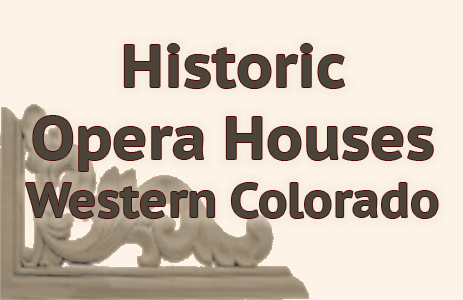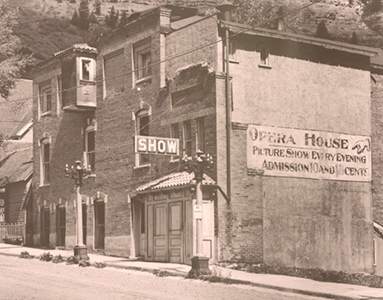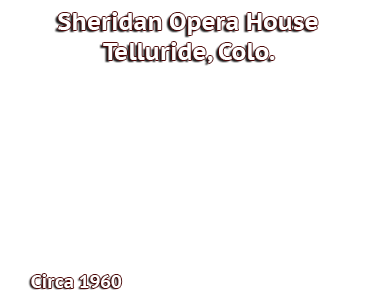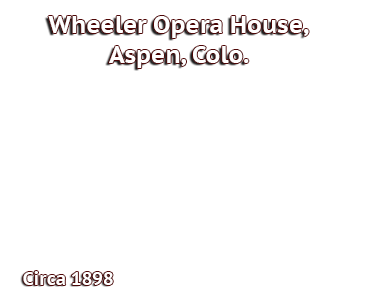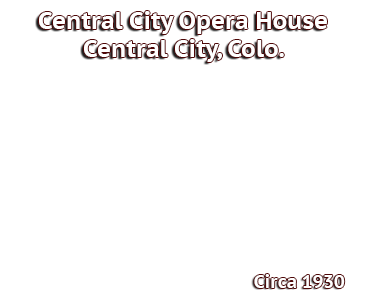Kate Burke’s Western History Series
Colorado’s Historic Opera Houses
| Sheridan Opera House, Telluride | Wright Opera House, Ouray | Wheeler Opera House, Aspen | Central City Opera House |
[San Juan Silver Stage | September 2021 | By Kathryn R. Burke] The event is part of a series presented about the region’s colorful history. Produced by Kate Burke, these afternoon programs are a joint effort of Kate and subject-related local and regional historical associations and museums.
Colorado’s historic opera houses provided exciting entertainment in the old mining towns, offering a variety of cultural programs to their extended communities (And no, these historic opera houses weren’t bordellos. That’s another story for another day.)
Ann Satterthwaite in her book Local Glories: Opera Houses on Main Street, Where Art and Culture Meet, writes that in Colorado, 132 opera houses were built in 68 towns between 1860 and 1920. Here in Western Colorado, many have been preserved and a surprising number are open today. Among them, are the Wright Opera House in Ouray, Sheridan Opera House in Telluride, Wheeler Opera House in Aspen, and the Central City Opera House in Central City, the oldest surviving opera house in Colorado
Boom & Bust
When the opera houses were built, back in the mining days, it was an exciting time, and many of the small towns we know now had much bigger populations. The stories of the era are fascinating, nearly impossible for us to conceive today. The towns sprang up fast, serving as supply centers and providing housing the miner’s families and businesses to support them. The towns offered bars, brothels, and gaming parlors for the men, but they also needed cultural opportunities for the more genteel population, along with churches and schools, stores and post offices, and of course… a railroad depot. People came to opera house events by train as well as wagon, stagecoach, and horse and buggy.
Sheridan Opera House, Telluride
During the 1880s, the town of Telluride, briefly known as Columbia, quickly blossomed into a small, mining supported community. Within 10 years the population had grown to 5,000 people. By 1909 the Telluride mining district had produced $60,000,000 in ore and the town soon became the attraction point for railroad excursions, picnics, circus acts, and riding clubs. As high culture blossomed, wealthy mine owners and aristocrats began to host lavish parties, balls, and evenings of entertainment. In 1912, J. A. Segerberg, manager of the New Sheridan Hotel, recognized Telluride’s need for a venue to host such events and began to develop the plans for a three-story intimate opera house. Construction of the Segerberg Opera House was completed in July of 1913 and featured delicately painted floral stencils throughout the theater The original decorative painting of the Opera House is a rare example of the transitional period between the Art Nouveau style of the late 1800s and the Craftsman style of the 1920s.
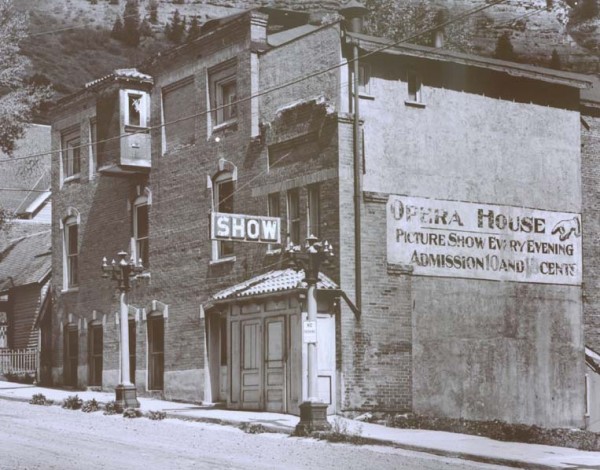
Sheridan Opera House, Telluride. 1960s-70. Public Domain.
The Segerberg Opera House survived a devastating flood the next year and a mud slide which buried the adjacent Sheridan Hotel in 10 feet of debris. The opera house eventually succumbed to prohibition in 1930, a period in which skiing began to become a popular pastime.
The Segerberg Theater reopened for organized programming in the early 1960s. Renamed the Sheridan Opera House after the neighboring New Sheridan Hotel, the opera house once again became home to live entertainment. In the early 1970s, after Telluride Ski Resort opened, and Telluride focused on community tourism, the Sheridan, then owned and restored by Bill and Stella Pence, hosted the still-popular Telluride Film Festival. But the building continued to deteriorate, and was in sever jeopardy of commercial development.
The Sheridan Arts Foundation, founded in 1991, came to the rescue, and along with the town of Telluride, restored the crumbling building—a ten year project, which was completed in by the spring of 2010. Today, the Sheridan Opera House is a popular, year-round entertainment venue which draws an audience from surrounding communities and visitors from around the world. [Story here]
Wheeler Opera House, Aspen
The stone building erected during the 1890s, from a design by Willoughby J. Edbrooke, blends elements of the Romanesque Revivial and Italianate architectural styles. In 1972, The Wheeler became the first property in Aspen to be listed on the National Register of Historic Places. It is one of two buildings in town named after early developer Jerome B. Wheeler. Originally, the opera house was located on the third floor, with retail space at street level and professional offices on the second floor.
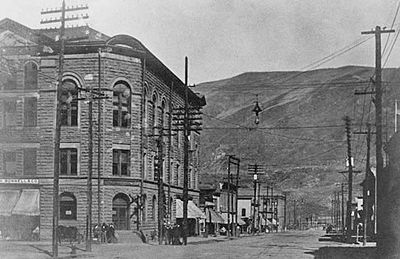
Wheeler Opera House, early 1900s. Public Domain.
Over the years, the building suffered from fires and neglect and eventually fell into disuse. By 1930, Aspen’s population reached its all-time low of just over 500‑just 1/10th of what it was in the peak mining days! After World War II, the Wheeler was partially restored and slowly entertainment resumed. Rehabilitation was completed in 1984. Within a few years, the theater fully capable of hosting all types of performances year-round, it became a popular venue, bringing in big names and hosting festivals. It is still undergoing various improvements today. [Read more here]
Wright Opera House, Ouray
In 1881, brothers Ed and George Wright purchased several lots at the southwestern corner of 5th Avenue & Main St. (Highway 550), where they first built the Wright Brothers Building, a two-story brick structure that was considered “a wonder of the time.” A few years later, to the south of this earlier building, the Wright brothers began construction of the Wright Opera House because Ed Wright and his wife, Letitia, believed that the populace of Ouray needed to be provided with cultural opportunities to offset the influence of the dance halls, saloons, gambling dens, and houses of ill repute. They wanted to create a decent establishment that would feature cultural and educational programs of high quality for the entertainment and enlightenment of the young people and adults within the community.

The theater front curtain, sometimes called an ‘olio’ often contained painted images depicting the theater’s architectural style or advertisements for local businesses. Wright Opera House website. *When The Friends of the Wright purchased the building in 2011, two main stage curtains were discovered in the basement – The Original and The Second. The Original curtain is in a delicate state of disrepair and cannot withstand the wear and tear of constant display. The Second curtain, however, is hung on the south wall of the Theatre. Courtesy Wright Opera House.
Together with the Beaumont Hotel, Ouray County Court House, School House, and Miners Hospital (which now houses the Ouray County Museum), the Wright Opera House, with its decorative iron front and balcony (by the Mesker Brothers Iron Works), was one of the most imposing brick structures in Ouray during the late 1880s and early 1890s. The grand opening of the Wright Opera House was held on December 4, 1888, with a benefit concert and ball.
A number of years elapsed before the local residents began to accept this new cultural center for Ouray. Attendance was spotty until the collapse of the mining era. Then, unlike what befell the Wheeler in Aspen which succumbed to the declining population there, the Wright gained in popularity as the town of Ouray continued to grow. More and more activities were held in the Wright Opera House, including cultural activities for the school. Musicians were brought from Denver and other more culturally rich areas to perform for the people in Ouray County. Finally the Wright Opera House became the center of activities for the city of Ouray and the remainder of the County during the early 1900s.
Mining towns are often the victims of ‘boom and bust’ a cycle which also impacted their opera houses. Curing the latter part of the 20th Century, Ouray’s population declined—mining slowed down and tourism hadn’t bloomed yet—and the Wright fell into a period of relative non-use. A few street-level establishments were open for business, but much of the interior of the building fell deteriorated; some of it being used for storage.
Today, thanks to year-round tourism, the Wright and the town of Ouray are booming again. Ongoing restoration, including installation of an elevator—the stage and show venue is on the second floor—and opening up a tavern in what was once a storage room, has given the Wright new life. Movies, theater, musical products, and movies and more now entertain locals and visitors alike, as the Wright Opera House once hosts cultural events for the public. [Story]
Central City Opera House, Central City
Technically, the Central City Opera House is not part of Western Colorado history. It is a predessor. But it is worth mentioning here, because it is the oldest opera house in Colorado. Located near Denver, in the Central City/Black Hawk Historic Districtv Constructed 1878, it has offered operatic and theatrical productions that drew prominent actors and performers from the beginning.
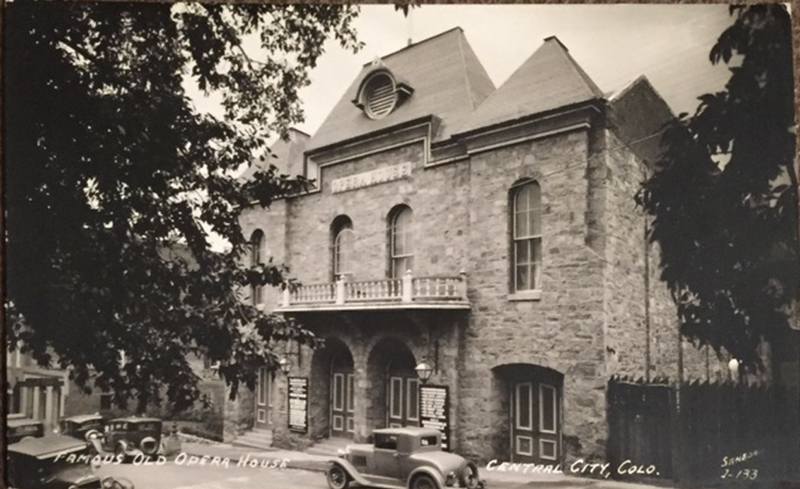
Central City Opera. Creative Commons license.
It was built by Welsh and Cornish miners and town residents, who had a tradition of music. Electricity was installed in 1896 and it was renovated, without structural changes in 1903. In 1910, it was opened it as a motion picture theatre, but fell into gradual disuse during the 1920s, and was closed in 1927. Two years later a dedicated band of Denver preservationists and music lovers formed the Central City Opera House Association to perform a renovation and re-open the opera house. In the 1980s and 1990s, the entire structure was restored, including the foundation and replacement of the 1920-era lighting relic by a computerized lighting system. In 1999, wooden chairs were replaced with plush new theater seating. Today, it is home to the
Today, Central City Opera, now in its 89th year of performances, presents world-class opera in an intimate historic venue and performs all of its operas in their original languages in the 550-seat jewel box opera house built in 1878. It also hosts the Central City Opera Festival is a four-week extravaganza of storytelling and powerful voices, featuring classical music’s biggest talents, the Central City Opera Orchestra and rising stars from the Bonfils-Stanton Foundation Artists Training Program.

